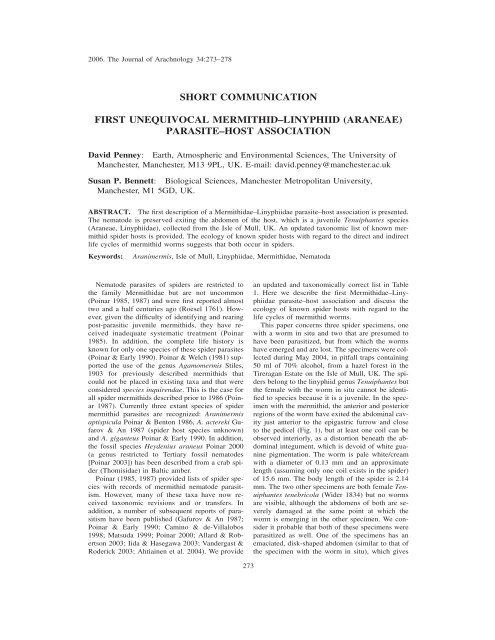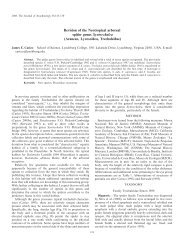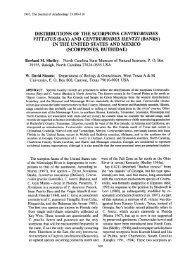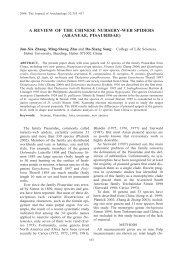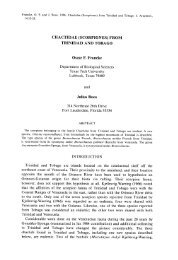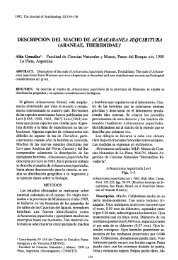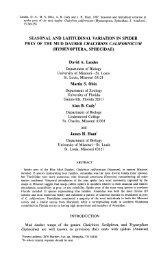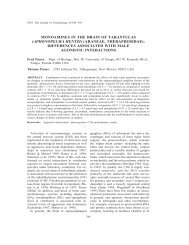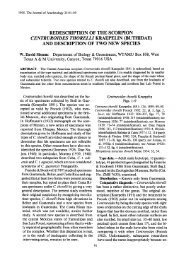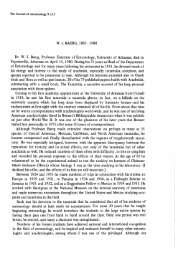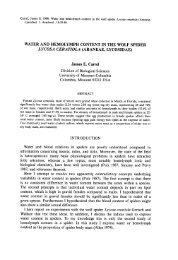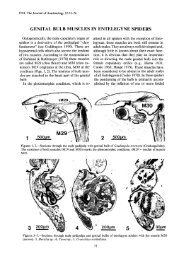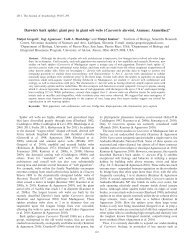Download Article - American Arachnological Society
Download Article - American Arachnological Society
Download Article - American Arachnological Society
Create successful ePaper yourself
Turn your PDF publications into a flip-book with our unique Google optimized e-Paper software.
2006. The Journal of Arachnology 34:273–278<br />
SHORT COMMUNICATION<br />
FIRST UNEQUIVOCAL MERMITHID–LINYPHIID (ARANEAE)<br />
PARASITE–HOST ASSOCIATION<br />
David Penney: Earth, Atmospheric and Environmental Sciences, The University of<br />
Manchester, Manchester, M13 9PL, UK. E-mail: david.penney@manchester.ac.uk<br />
Susan P. Bennett: Biological Sciences, Manchester Metropolitan University,<br />
Manchester, M1 5GD, UK.<br />
ABSTRACT. The first description of a Mermithidae–Linyphiidae parasite–host association is presented.<br />
The nematode is preserved exiting the abdomen of the host, which is a juvenile Tenuiphantes species<br />
(Araneae, Linyphiidae), collected from the Isle of Mull, UK. An updated taxonomic list of known mermithid<br />
spider hosts is provided. The ecology of known spider hosts with regard to the direct and indirect<br />
life cycles of mermithid worms suggests that both occur in spiders.<br />
Keywords: Aranimermis, Isle of Mull, Linyphiidae, Mermithidae, Nematoda<br />
Nematode parasites of spiders are restricted to<br />
the family Mermithidae but are not uncommon<br />
(Poinar 1985, 1987) and were first reported almost<br />
two and a half centuries ago (Roesel 1761). However,<br />
given the difficulty of identifying and rearing<br />
post-parasitic juvenile mermithids, they have received<br />
inadequate systematic treatment (Poinar<br />
1985). In addition, the complete life history is<br />
known for only one species of these spider parasites<br />
(Poinar & Early 1990). Poinar & Welch (1981) supported<br />
the use of the genus Agamomermis Stiles,<br />
1903 for previously described mermithids that<br />
could not be placed in existing taxa and that were<br />
considered species inquirendae. This is the case for<br />
all spider mermithids described prior to 1986 (Poinar<br />
1987). Currently three extant species of spider<br />
mermithid parasites are recognized: Aranimermis<br />
aptispicula Poinar & Benton 1986, A. actereki Gufarov<br />
& An 1987 (spider host species unknown)<br />
and A. giganteus Poinar & Early 1990. In addition,<br />
the fossil species Heydenius araneus Poinar 2000<br />
(a genus restricted to Tertiary fossil nematodes<br />
[Poinar 2003]) has been described from a crab spider<br />
(Thomisidae) in Baltic amber.<br />
Poinar (1985, 1987) provided lists of spider species<br />
with records of mermithid nematode parasitism.<br />
However, many of these taxa have now received<br />
taxonomic revisions and or transfers. In<br />
addition, a number of subsequent reports of parasitism<br />
have been published (Gafurov & An 1987;<br />
Poinar & Early 1990; Camino & de-Villalobos<br />
1998; Matsuda 1999; Poinar 2000; Allard & Robertson<br />
2003; Iida & Hasegawa 2003; Vandergast &<br />
Roderick 2003; Ahtiainen et al. 2004). We provide<br />
273<br />
an updated and taxonomically correct list in Table<br />
1. Here we describe the first Mermithidae–Linyphiidae<br />
parasite–host association and discuss the<br />
ecology of known spider hosts with regard to the<br />
life cycles of mermithid worms.<br />
This paper concerns three spider specimens, one<br />
with a worm in situ and two that are presumed to<br />
have been parasitized, but from which the worms<br />
have emerged and are lost. The specimens were collected<br />
during May 2004, in pitfall traps containing<br />
50 ml of 70% alcohol, from a hazel forest in the<br />
Tireragan Estate on the Isle of Mull, UK. The spiders<br />
belong to the linyphiid genus Tenuiphantes but<br />
the female with the worm in situ cannot be identified<br />
to species because it is a juvenile. In the specimen<br />
with the mermithid, the anterior and posterior<br />
regions of the worm have exited the abdominal cavity<br />
just anterior to the epigastric furrow and close<br />
to the pedicel (Fig. 1), but at least one coil can be<br />
observed interiorly, as a distortion beneath the abdominal<br />
integument, which is devoid of white guanine<br />
pigmentation. The worm is pale white/cream<br />
with a diameter of 0.13 mm and an approximate<br />
length (assuming only one coil exists in the spider)<br />
of 15.6 mm. The body length of the spider is 2.14<br />
mm. The two other specimens are both female Tenuiphantes<br />
tenebricola (Wider 1834) but no worms<br />
are visible, although the abdomens of both are severely<br />
damaged at the same point at which the<br />
worm is emerging in the other specimen. We consider<br />
it probable that both of these specimens were<br />
parasitized as well. One of the specimens has an<br />
emaciated, disk-shaped abdomen (similar to that of<br />
the specimen with the worm in situ), which gives
274 THE JOURNAL OF ARACHNOLOGY<br />
Table 1.—Spider hosts of mermithid worms: * A. aptispicula, **A. giganteus, remainder species inquirendae.<br />
Family Species Reference Comments<br />
Agelenidae Agelenopsis oregonensis Chamberlin<br />
& Ivie 1935<br />
in Poinar (1987)<br />
Amaurobiidae Eurocoelotes inermis (L. Koch<br />
1855)<br />
in Poinar (1987) as Coelotes i.<br />
Antrodiaetidae Atypoides riversi O.P.-Cambridge<br />
1833<br />
in Poinar (1987)<br />
Anyphaenidae Wulfila albens (Hentz, 1847)* in Poinar (1987) as W. alba<br />
Araneidae Aculepeira ceropegia (Walckenaer<br />
1802)<br />
in Poinar (1987) as Araneus ceropegius<br />
Araneidae Araneus diadematus Clerck 1757 in Poinar (1987)<br />
Araneidae Verrucosa arenata (Walckenaer<br />
1842)*<br />
in Poinar (1987)<br />
Ctenidae Leptoctenus byrrhus Simon 1888 Poinar (2000) as Ctenus bryrrbus<br />
Cybaeidae Argyroneta aquatica (Clerck<br />
1757)<br />
in Poinar (1987)<br />
Gnaphosidae Cesonia bilineata (Hentz 1847)* in Poinar (1987)<br />
Gnaphosidae Gnaphosa lucifuga (Walckenaer<br />
1802)<br />
in Poinar (1987)<br />
Hexathelidae Porrhothele antipodiana (Wal- Poinar & Early as P. a. (Dipluridae)<br />
ckenaer 1837)**<br />
(1990)<br />
Idiopidae Misgolas borealis (Forster Poinar & Early as Cantuaria b. (Cteni-<br />
1968)**<br />
(1990)<br />
zidae)<br />
Linyphiidae? Micryphantes bicuspidatus C.L. in Poinar (1987) nomen dubium (Plat-<br />
Koch 1838<br />
nick 2004)<br />
Lycosidae Alopecosa inquilina (Clerck 1757) in Poinar (1987) as Tarentula i.<br />
Lycosidae Alopecosa trabalis (Clerck 1757) in Poinar (1987) as Lycosa vorax<br />
Lycosidae Arctosa alpigena (Doleschall<br />
1852)<br />
Poinar (2000) possible mermithid<br />
Lycosidae Geolycosa patellonigra Wallace<br />
1942<br />
in Poinar (1987)<br />
Lycosidae Hygrolycosa rubrofasciata (Ohlert Ahtiainen et al.<br />
1865)<br />
(2004)<br />
Lycosidae Pardosa agrestis (Westring 1861) in Poinar (1987)<br />
Lycosidae Pardosa amentata (Clerck 1757) in Poinar (1987) as Lycosa saccata<br />
Lycosidae Pardosa furcifera (Thorell 1875) in Poinar (1987)<br />
Lycosidae Pardosa glacialis (Thorell 1872) in Poinar (1987)<br />
Lycosidae Pardosa hortensis (Thorell 1872) in Poinar (1987)<br />
Lycosidae Pardosa lugubris (Walckenaer<br />
1802)<br />
in Poinar (1987)<br />
Lycosidae Pardosa milvina (Hentz 1844) in Poinar (1987) as P. nigropalpis and<br />
P. scita<br />
Lycosidae Pardosa palustris (Linneaus 1758) in Poinar (1987) as Lycosa tarsalis<br />
Lycosidae Pardosa pseudoannulata (Boesen- Iida & Hasegawa<br />
berg & Strand 1906)<br />
(2003)<br />
Lycosidae Pardosa riparia (C.L. Koch 1833) in Poinar (1987)<br />
Lycosidae Pardosa sphagnicola (Dahl 1908) in Poinar (1987) as Lycosa riparia s.<br />
Lycosidae Pardosa suwai Tanaka 1985 Matsuda (1999)<br />
Lycosidae Pardosa vancouveri Emerton<br />
1917<br />
in Poinar (1987)<br />
Lycosidae Rabidosa rabida (Walckenaer<br />
1837)<br />
in Poinar (1987) as Lycosa scutulata<br />
Lycosidae Schizocosa saltatrix (Hentz 1844) in Poinar (1987) as Lycosa versimilis<br />
Lycosidae Sosippus floridanus Simon 1898 in Poinar (1987)<br />
Nemesiidae Stanwellia kaituna (Forster Poinar & Early as Aparua k. (Dipluri-<br />
1968)**<br />
(1990)<br />
dae)
PENNEY & BENNETT—MERMITHID–LINYPHIID PARASITE–HOST<br />
Table 1.—Continued.<br />
Family Species Reference Comments<br />
Oxyopidae Oxyopes sertatus L. Koch 1877 Okochi (1969)<br />
Oxyopidae Peucetia viridans (Hentz 1832) in Poinar (1987)<br />
Philodromidae Tibellus oblongus (Walckenaer<br />
1802)<br />
in Poinar (1987)<br />
Salticidae Habronattus signatus (Banks Vandergast &<br />
1900)<br />
Roderick (2003)<br />
Salticidae Myrmarachne formicaria (De<br />
Geer 1778)<br />
in Poinar (1987) as Salticus formicarius<br />
Salticidae Phidippus borealis Banks 1895 in Poinar (1987)<br />
Salticidae Phidippus clarus Keyserling 1885 in Poinar (1987)<br />
Salticidae Phidippus johnsoni (Peckham &<br />
Peckham 1883)<br />
in Poinar (1987)<br />
Salticidae Phidippus putnami (Peckham &<br />
Peckham 1883)<br />
in Poinar (1987)<br />
Salticidae Sitticus floricola palustris (Peckham<br />
& Peckham 1883)<br />
in Poinar (1987) as Sitticus p.<br />
Stiphidiidae Cambridgea foliata (L. Koch<br />
1872)<br />
in Poinar (1987)<br />
Tetragnathidae Tetragnatha anuenue Gillespie Vandergast &<br />
2002<br />
Roderick (2003)<br />
Tetragnathidae Tetragnatha brevignatha Gillespie Vandergast &<br />
1991<br />
Roderick (2003)<br />
Tetragnathidae Tetragnatha praedonia L. Koch<br />
1878<br />
Okochi (1969)<br />
Tetragnathidae Tetragnatha quasimodo Gillespie Vandergast &<br />
1991<br />
Roderick (2003)<br />
Theridiidae Enoplognatha ovata (Clerck 1757) in Poinar (1987) as Theridion ovatum<br />
and T. redimitum<br />
Thomisidae Diaea dorsata (Fabricius 1777) in Poinar (1987)<br />
Thomisidae Misumenops tricuspidatus (Fabricius<br />
1775)<br />
Okochi (1969)<br />
Thomisidae Xysticus deichmanni Soerensen<br />
1898<br />
in Poinar (1987)<br />
Thomisidae Xysticus durus (Soerensen 1898) in Poinar (1987)<br />
Thomisidae Xysticus funestus Keyserling 1880 in Poinar (1987)<br />
Zoridae Zora maculosa Roewer 1951 in Poinar (1987) as Z. maculata O.P.-C;<br />
nomen dubium (Platnick<br />
2005)<br />
the impression of having been host to a worm. It<br />
has a normal degree of guanine pigmentation. The<br />
second specimen is not emaciated and has almost<br />
no guanine pigmentation. It cannot be ruled out that<br />
the specimens were damaged upon sorting the pitfall<br />
trap contents, but as no other spiders (including<br />
many smaller species) were damaged, we consider<br />
this unlikely. Alternatively, they may have been<br />
hosts to non-mermithid parasites, such as acrocerids<br />
or phorids. Unfortunately, the pitfall contents are no<br />
longer available to check for emerged worms. It is<br />
probable that the specimen with the worm also belongs<br />
to T. tenebricola, given that six other individuals<br />
(three males and three females) were also<br />
collected at the same time from the same locality,<br />
275<br />
whereas only one female of each of the following<br />
species was collected: T. alacris (Blackwall 1853),<br />
T. cristatus (Menge 1866) and T. mengei (Kulczynski<br />
1882).<br />
Poinar (1985, 1987) cited von Siebold (1848) as<br />
having identified an unknown mermithid worm in<br />
the spider Micryphantes bicuspidatus (listed in Table<br />
1 under Linyphiidae?). At the time of von Siebold’s<br />
paper (his description consisted of only five<br />
lines and no figures), only six spider families had<br />
been established, Linyphiidae was not erected until<br />
1859. The genus Micryphantes C.L. Koch 1833 and<br />
M. bicuspidatus are both nomina dubia (Platnick<br />
2005). Therefore, the new specimen described here<br />
represents the first described record of a mermithid–
276 THE JOURNAL OF ARACHNOLOGY<br />
Figure 1.—The mermithid-carrying spider. Note the absence of abdominal guanine pigmentation, arrows<br />
point to the internal coil of the worm visible as a distortion in the integument. Scale lines � 1.0 mm.<br />
linyphiid parasite–host association. Furthermore,<br />
the claims of Allard & Robertson (2003) of having<br />
identified mermithids in Pardosa milvina (Hentz)<br />
(Lycosidae) for the first time are unjustified, because<br />
they were previously reported by Montgomery<br />
(1903) under the junior synonyms Pardosa nigropalpis<br />
Emerton 1885 and Pardosa scita<br />
Montgomery 1902.<br />
Being host to the worm carries a physiological<br />
cost for the spider in addition to its ultimate demise<br />
upon the emergence of the parasite. Infection signs<br />
generally start with a reduction or absence of digestive<br />
structures, and other organs may also be reduced<br />
in extreme cases (Poinar 1985). It is interesting<br />
to note the reduced amount of guanine<br />
deposition in two of the above specimens, and indeed<br />
the total absence of it in the specimen with<br />
the worm. Guanine is a crystalline purine excretory<br />
product, which accumulates in specialized, peripheral<br />
cells of the digestive diverticula lying directly<br />
beneath the hypodermis (Oxford & Gillespie 1998)<br />
and has a white, blocky appearance. Although patterns<br />
of guanine deposition can vary intraspecifically<br />
and throughout an individuals’ development<br />
(Oxford 1998), there is usually a distinct pattern of<br />
guanine pigmentation present in Tenuiphantes Saaristo<br />
& Tanasevitch 1996 specimens (DP pers. obs).<br />
In the case of mermithid-carrying individuals however,<br />
the worm may be compromising the spider to<br />
such an extent, that the spider is receiving insufficient<br />
nourishment to produce enough of these met-<br />
abolic waste products for pigmentation purposes.<br />
Further research would be required to confirm this<br />
hypothesis.<br />
At the time of emergence from the spider host,<br />
mermithid worms are mature third stage postparasitic<br />
juveniles. Thus, the individual described<br />
above cannot be identified to species because diagnosis<br />
is based on adult characters. Mermithid life<br />
cycles are either direct or indirect. Direct life cycles<br />
are characterized by direct penetration of the spider<br />
host through the integument by the infective stage<br />
larva following emergence from the egg. Indirect<br />
life cycles involve a paratenic host (or a host in<br />
which significant development does not occur) in<br />
addition to the developmental (spider) host, which<br />
is infected by ingesting the infective stage of the<br />
parasite (Poinar 1985). The direct cycle is by far<br />
the most common among mermithids studied to<br />
date, however, it has been suggested that spider<br />
mermithids first undergo an indirect life cycle involving<br />
an aquatic paratenic host (Poinar 1987).<br />
Reasoning for this was based on observations of the<br />
life cycle of the spider mermithid Aranimermis aptispicula<br />
as follows: ‘‘adults were found in an<br />
aquatic habitat, whereas parasitized spiders were<br />
found in a variety of foraging habitats. Parasitized<br />
spiders were observed to enter the water and the<br />
nematodes were seen to emerge from the hosts’<br />
bodies. These observations support an indirect type<br />
of cycle, but further studies are required to substantiate<br />
this’’ (Poinar 1987). Poinar (1987) did not rule
PENNEY & BENNETT—MERMITHID–LINYPHIID PARASITE–HOST<br />
out that some spider mermithid species may also<br />
have a direct life cycle. The life cycle of A. actereki<br />
presumably has an indirect life cycle because all<br />
worms studied (12 males, two females and four<br />
post-parasitic larvae) were collected from the bottom<br />
of a freshwater spring (Gufarov & An 1987).<br />
A. giganteus from New Zealand does have an indirect<br />
life cycle involving aquatic invertebrates<br />
(Poinar & Early 1990).<br />
Given that most aquatic insect larvae have<br />
winged adults, the ecology of the spider hosts may<br />
provide insights that support or refute Poinar’s idea<br />
regarding the indirect life cycle of A. aptispicula.<br />
For example, winged, flying insects are more likely<br />
to be consumed by web spinning or foliage/flower<br />
hunting spiders than they are by non-web spinning,<br />
ground hunters or burrowing, sit and wait predators,<br />
which can be expected to feed primarily on nonflying,<br />
mainly fully terrestrial prey and are thus,<br />
more likely to be hosts to mermithids with a direct<br />
life cycle. Interestingly, the ecology of all but one<br />
of the spiders reported by Poinar & Benton (1986)<br />
as hosts of A. aptispicula (Gnaphosidae, Cesonia<br />
bilineata; Thomisidae, Misumenops sp. and Tmarus<br />
sp.; Salticidae, Phidippus sp.; Araneidae, Verrucosa<br />
arenata; Amaurobiidae, Wadotes sp. and Anyphaenidae,<br />
Wulfila albens), supports the idea of an<br />
indirect life cycle for this parasitic worm. The potential<br />
problem species of those listed is C. bilineata<br />
(Gnaphosidae). These are fast moving, agile<br />
hunters usually found under loose leaf litter at<br />
ground level and males are often found in pitfall<br />
traps. However, they have been collected by sweeping<br />
low vegetation and have also been collected<br />
from malaise traps (Platnick & Shadab 1980),<br />
which are primarily designed for catching flying insects.<br />
The large number of non-web spinning, cursorial<br />
Lycosidae (Table 1; 38% of all species, excluding<br />
nomina dubia) with undescribed mermithids, suggests<br />
that a direct life cycle may be involved in<br />
some instances. Admittedly, some lycosids are<br />
common by freshwater, such as Hygrolycosa rubrofasciata<br />
and Pardosa pseudoannulata (known to<br />
be mermithid hosts, see Table 1) and may be hosts<br />
to worms with indirect life cycles. However, lycosid<br />
genera such as Pirata and the pisaurid genus Dolomedes,<br />
which are encountered almost exclusively<br />
near freshwater are unknown as mermithid hosts.<br />
The mermithid life cycle type in relation to the spider<br />
host Argyroneta aquatica also poses interesting<br />
questions, as this spider spends its entire life under<br />
water. Clearly, much work needs to be done before<br />
we can fully understand these interesting host–parasite<br />
relationships, but a knowledge of the ecology<br />
of the host spiders can provide helpful clues in resolving<br />
these.<br />
We thank G.O. Poinar Jr. (Oregon State University)<br />
for his comments on the manuscript, J. Dunlop<br />
277<br />
(Museum für Naturkunde, Berlin) for providing old<br />
German literature and D. Logunov (Manchester<br />
Museum) for translating a Russian paper. DP acknowledges<br />
a Leverhulme Trust grant to P. Selden<br />
and SB thanks L. Lace (Manchester Metropolitan<br />
University) for assistance and advice.<br />
LITERATURE CITED<br />
Ahtiainen, J.J., R.V. Alatalo, R. Kortet & M.J. Rantala.<br />
2004. Sexual advertisement and immune<br />
function in arachnid species (Lycosidae). Behavioural<br />
Ecology 15:602–606.<br />
Allard, C. & M.W. Robertson. 2003. Nematode and<br />
dipteran endoparasites of the wolf spider Pardosa<br />
milvina (Araneae, Lycosidae). Journal of<br />
Arachnology 31:139–141.<br />
Camino, N.B. & L.C. de Villalobos. 1998. First occurrence<br />
of a mermithid (Nematoda: Mermithidae)<br />
parasitizing a spider (Arachnida: Araneida)<br />
in Argentina. Revista de la Sociedad Entomologica<br />
Argentina 57:6.<br />
Gafurov, A.K. & P.N. An. 1987. A new species of<br />
mermithid Aranimermis actereki sp. n. (Mermithidae,<br />
Nematoda) from the Kirghizia. Izvestiya<br />
Akademii Nauk Kirgizskoi SSR Khimiko Tekhnologicheskie<br />
Biologicheskie Nauki 1987:79–82.<br />
[In Russian].<br />
Iida, H. & H. Hasegawa. 2003. First record of a<br />
mermithid nematode emerging from the wolf<br />
spider Pardosa pseudoannulata (Araneae: Lycosidae).<br />
Acta Arachnologica 52:77–78.<br />
Matsuda, M. 1999. Two intersexual spiders of the<br />
family Lycosidae from Japan. Bulletin of the Higashi<br />
Taisetsu Museum of Natural History 21:5–<br />
54. [In Japanese].<br />
Montgomery, T.H. 1903. Studies on the habits of<br />
spiders, particularly those of the mating period.<br />
Proceedings of the Academy of Natural Sciences<br />
of Philadelphia 55:80–90.<br />
Okochi, T. 1969. Reports on parasites of spiders.<br />
Kishidaia 9:2–. [In Japanese].<br />
Oxford, G.S. 1998. Guanine as a colorant in spiders:<br />
development, genetics, phylogenetics and<br />
ecology. Pp. 121–131. In Proceedings of the 17th<br />
European Colloquium of Arachnology, Edinburgh,<br />
1997. (P.A. Selden, ed.). British <strong>Arachnological</strong><br />
<strong>Society</strong>, Bucks.<br />
Oxford, G.S. & R.G. Gillespie. 1998. Evolution and<br />
ecology of spider coloration. Annual Review of<br />
Entomology 43:619–643.<br />
Platnick, N.I. 2005. The world spider catalog, version<br />
5.5. <strong>American</strong> Museum of Natural History,<br />
online at http://research.amnh.org/entomology/<br />
spiders/catalog/INTRO1.html.<br />
Platnick, N.I. & M.U. Shadab. 1980. A revision of<br />
the spider genus Cesonia (Araneae, Gnaphosidae).<br />
Bulletin of the <strong>American</strong> Museum of Natural<br />
History. 165:335–386.<br />
Poinar, G.O. Jr. 1985. Mermithid (Nematoda) par-
278 THE JOURNAL OF ARACHNOLOGY<br />
asites of spiders and harvestmen. Journal of Arachnology<br />
13:121–128.<br />
Poinar, G.O. Jr. 1987. Nematode parasites of spiders.<br />
Pp. 299–308. In Ecophysiology of Spiders.<br />
(W. Nentwig, ed.). Springer Verlag, Heidelberg.<br />
Poinar, G.O. Jr. 2000. Heydenius araneus n. sp.<br />
(Nematoda: Mermithidae), a parasite of a fossil<br />
spider, with an examination of helminths from<br />
extant spiders (Arachnida: Araneae). Invertebrate<br />
Biology 119:388–393.<br />
Poinar, G.O. Jr. 2003. Trends in the evolution of<br />
insect parasitism by nematodes as inferred from<br />
fossil evidence. Journal of Nematology 35:129–<br />
132.<br />
Poinar, G.O. Jr. & C.L.B. Benton Jr. 1986. Aranimermis<br />
aptispicula n.g., n.sp. (Mermithidae:<br />
Nematoda), a parasite of spiders. Systematic Parasitology<br />
8:33–38.<br />
Poinar, G.O. Jr. & J.W. Early. 1990. Aranimermis<br />
giganteus n. sp. (Mermithidae: Nematoda), a par-<br />
asite of New Zealand mygalomorph spiders (Araneae:<br />
Arachnida). Revue de Nématologie 13:<br />
403–410.<br />
Poinar, G.O. Jr. & H.E. Welch. 1981. Parasites of<br />
invertebrates in the terrestrial environment. Pp.<br />
947–954. In Review of Advances in Parasitology.<br />
(W. Slusarski, ed.). Polish Scientific Publications,<br />
Warsaw.<br />
Roesel, A.J. 1761. Insectenbelustigung. Johann Joseph<br />
Fleishmann, Nürnberg.<br />
Vandergast, A.G. & G.K. Roderick. 2003. Mermithid<br />
parasitism of Hawaiian Tetragnatha spiders<br />
in a fragmented landscape. Journal of Invertebrate<br />
Pathology 84:128–136.<br />
von Siebold, C.T.E. 1848. Ueber die Fadenwurmer<br />
der Insekten. Entomologische Zeitung 9:290–<br />
300.<br />
Manuscript received 16 November 2004, revised 21<br />
April 2005.


